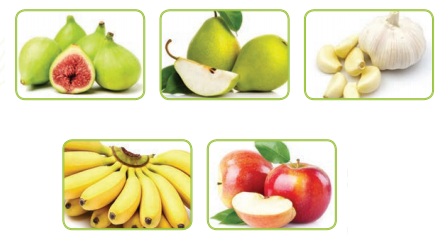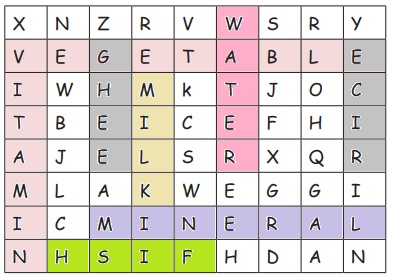Term 2 Chapter 1 | 3rd Science - Food | 3rd Science : Term 2 Unit 1 : Food
Chapter: 3rd Science : Term 2 Unit 1 : Food
Food
Unit 1
Food

Learning Objectives
After learning this lesson, students will be able to
*
classify different nutrients in food
*
describe balanced diet
*
distinguish between various meals in a day
*
understand the different food habits based on the places and age groups
* identify traditional food and explain the advantages of a home
garden
Warm-up
Observe the picture and answer the questions given below.

a. The food items which should be avoided are
indicated by red colour.
b. The food items which are healthy are indicated by
yellow colour.
c. The food items which can be eaten in small
quantities are indicated by green
colour.
I. Food
Nutrients
Think: Why do you eat every day? What happens if you don‛t eat
sometimes?
Every day we feel hungry and then eat something.
Our body is telling us that it needs food. Why do we need food?
* Food gives us energy to work and play.
* Food builds our body.
* Food keeps us healthy.
We eat different food items, some are raw and some are cooked.
Each of these food items contains different nutrients. There are five main nutrients that our body requires. They are carbohydrates, proteins, fats, vitamins and minerals.
Do you know: World Food Day is observed on October-16.
1. Carbohydrates
Our body needs energy to do work, play and do other activities.
Carbohydrates are energy-giving food. Food that
contains carbohydrate are rice, wheat, potato, sugar cubes and bread.

2. Proteins
Proteins build, maintain and replace the tissues in our body.
They are also known as body - building foods. E.g., Fish, Milk, Egg, Nuts
and Sprouted seeds.

3. Fats
Fats provide energy to us. They act as the body‛s energy reservoir. Fats also help to keep the body warm during very cold weather.
Too much fat in the body may lead to obesity or overweight. Some food items
that contain fat are cheese, butter, ghee, meat, oil and nuts.

4. Vitamins
Our body needs vitamins to work properly. They protect our body from deficiency
diseases. E.g.,
Carrot,
Orange, Gooseberry, Papaya and Greens.

5. Minerals
Minerals help in formation of blood, bone, teeth, etc. They regulate the body
functions. E.g., Fig, Pear, Garlic,
Banana and Apple.

Let us Write

Energy – Giving Food Items
1. Rice
2. Wheat
3. Potato
4. Bread
Body – Protecting Food Items
1. Carrot
2. Orange
3. Papaya
Body - Building Food Items
1. Milk
2. Sprouted seeds
3. Egg
4. Nuts
Be Sensitive
Most children love to eat food items like
burgers, pizzas and chocolates, which are not good for health. They make
children to gain extra weight.
Avoid eating unhealthy foods and eat nutritious food to stay
healthy. A healthy snack may include sprouts, fruits and salads.
Let us
Write
A. What are the nutrients present in the following food items?
1. Rice contains Carbohydrate
2. Coconut oil contains Fat
3. Egg contains Proteins
4. Fig contains Minerals
5. Carrot contains Vitamins
B. Fill in the table given below.

II. Balanced diet
Diet refers to the food we eat. A balanced diet contains all nutrients in the right amounts. It also includes fibre and water. It helps in the growth and development of our body.
The quantity of nutrients required by our body and their sources
can be shown by a food pyramid.
The food item that should be eaten in the least amount is
kept at the top of the pyramid.
A balanced diet food pyramid is shown here.

Roughage, also known as fibre is an indigestible food that your
body cannot absorb. It is present in food such as legumes, whole grains and
vegetables.
Milk is a complete
balanced diet.
More to
know
*
Carrot contains Vitamin-A
*
Bran contains Vitamin-B
*
Gooseberry contains Vitamin-C
*
Milk contains Vitamin-D
*
Sunflower oil contains Vitamin-E
* Cabbage contains Vitamin-K
Let us Find
Unscramble the
following words and search them in the given grid (One is done for you).

ELBATEGEV – VEGETABLE
AITVIMN - VITAMIN
INMELAR – MINERAL
MKIL -MILK
WTERA - WATER
HEGE -GHEE
RCIE -RICE
GEG -EGG
FSHI - FISH
Let us Do
Design a meal for
your lunch.
Health Care!
Drink plenty of water every day. We should not spill the food while eating.
My Menu: Rice, Dal, Ghee, Curd, Banana, Rasam, Leech, Pickel, Water

To check whether it
is a balanced diet, split your meal according to the nutrients.

Yes it is a balanced diet
III.
Meals in a day
A
meal is what we eat during a particular time of the day. Breakfast, lunch and dinner are the three main meals we eat
every day.
Kaviya and Suriya are studying III standard. They leave home at 8.00 am to go to school and they have their breakfast before going to
school. Their mother usually makes food items like idly, dosa, bread with egg,
ragi koozh, idiyappam, poori, aappam and pongal.
Think:
What do you usually eat for breakfast?
We usually eat idly
for breakfast.

At 12.40 pm, the school bell rings
to announce lunch break. Kaviya and Suriya
both wash
their hands and sit down to eat lunch
with their friends. All of them place their lunch towel on the floor and start
eating.
Kaviya, Suriya and their friends share their lunch, which
include lemon rice, fruit salad, greens, rice along with sambar, biriyani,
tomato rice, vegetable salad, curd rice, tamarind rice and cereals.

Think: Which of the food items that are brought by your friends for lunch?
Sambar rice, biriyani, curd rice, lemon rice, tomato rice,
tamarind rice etc.
Kaviya and Suriya have their dinner
half an hour before going to bed. They like
having chappathi, milk and fruits, and on some days idli, dosa or rice.
Think: At what time you go to bed every day?
I go to bed at 9 p.m every day.
Think: At what time you have
your dinner?
I have my dinner at 7.30 p.m
Let us Do
Ask your friends what they like to eat and complete the table.

Try to Answer
Look at the pictures
of different activities.

1. Which activities are healthy? 2,4,5
2. Which activities are not so healthy? 1,3
Do you know
The amount of time you should spend for washing your hands each
time before eating is at least 20 seconds. That is about as long as it takes
you to sing the ‘happy birthday‛ song twice! Try it when you wash your hands
next time.
IV. Food
Habits in Different Places
Food habit of people at a place depends on the climate, culture and availability of food. For example, in coastal areas, people eat a lot of sea food.
India is a big country with different climate and culture.
South Indians depend on rice, dhal, coconut, jaggery for their food. Hence,
they make food like Idly, Sambar, Kozhukkattai and Payasam.

North Indians depend on wheat, onions, milk and curd. Hence, they make foods
like Chappathi, Paratha and Lassi.

Food habits in Different Age Groups
The amount of food a person needs depends on his age. These
needs change with age groups and level of physical activity. Athletes may need more amount of energy during training. Young children should eat a wide variety of
food.
The following food items can be eaten by the people of different
age groups in order to maintain good health.

Children: Milk, honey, fruits, vegetables, whole grains, egg, sprouted seeds and fish.
Young Adult
Old Adult: Fibrous food, low fat dairy products, food with less salt, ragi, thinai and pearl millet (kambu).
Try to Answer
Some of the famous food items of Tamil Nadu are given below.
Write the food items of the particular place.
(halwa, murukku,
jackfruit, spices, kadalai mittai, mango, tea)
1. Manapparai is famous for murukku
2. The nilgiris is famous for tea
3. Panruti is famous for jackfruit
4. Kollimalai is famous for spices
5. Tirunelveli is famous for halwa
6. Kovilpatti is famous for kadalai mittai
7. Salem is famous for mango
Let us Discuss
Observe the pictures. Who needs more nutritious food? Why?

B. needs more
nutritious food. The man is doing physical work. He needs more energy to pull
the cart.
Try to Answer
Do your parents prepare the same food items for all festivals? If not, write the name of special food items prepared on different festivals.

Compare and discuss
your list with that of your friends.
V. Traditional
Food
Our ancestors ate food that were easily available from nature,
which lead to healthy lives. Few natural
foods are Ragi, Thinai, Samai,
Kuthiraivaali, Varagu and Kambu.

Different Varities of
Ragi Food : Ragi ball, Dosa, Adai,
Vermicelli and Biscuits.

Do you know
Do you eat Ragi? Of all the cereals we eat, ragi
is the best body builder and the disease fighter.
Home Garden
Cultivation of crops in a small available place in house-holds is known a Home garden or
Kitchen garden or Nutrition garden. E.g.,
Vegetables like tomatoes, brinjal, snake gourd, snap beans, lady‛s finger and
fruits like banana, lemon and also herbs.

Advantage of Home Garden
* It is the easiest method.
* Waste water can be reused.

* It saves our money.
* We get vegetables which are fresh and high in nutritive value.
Let us Do
A. Colour the circle in ‘GREEN‛ for traditional food and ‘RED‛ for modern food.

B. Using watercan / coconut shells, make a mini garden in your class rooms.
